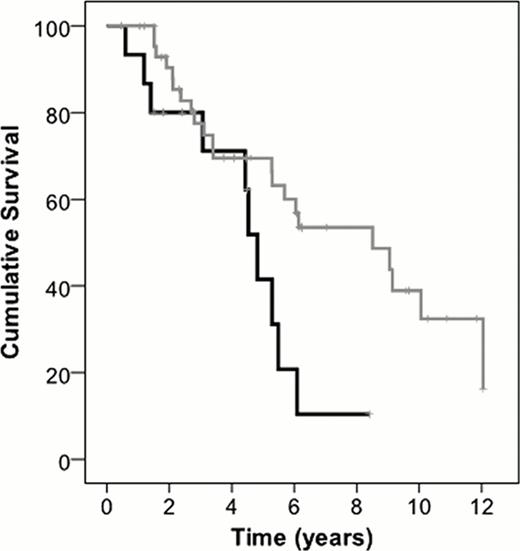Abstract
Abstract 1817
Identifying patients with optimal response and long survival is important for clinical guidance because patients with these features are likely not to need further therapy. The techniques applied for classifying these patients should be readily available, standardized, and not liable to subjective interpretation. Here we compare the clinical usability of Hevylite™ (HLC) assay, FLC assay, IFE (immunofixation electropheresis), PMPC (bone marrow plasma cell) infiltration and isotype suppression for identifying patients at their best response with long term survival.
65 multiple myeloma patients (median age at maximum response 64, range 33–85; 42 IgG, 23 IgA) were enrolled following the minimum assignment of very good partial response using international myeloma working group guidelines. Patients had been enrolled into various clinical trials and been treated with different induction protocols (VAMP, VMCP+IFNa2b, Thal-Dex, MP, VMP). Median follow was 4.5 years, range 0.5–12 years. Heavy/light chain analysis was retrospectively performed for the monoclonal plasma cell immunoglobulin and its isotype matched pair (42 IgGκ / IgGλ and 23 IgAκ / IgAλ) using commercially available immunoassays (Hevylite™, The Binding Site, Birmingham, UK). Isotype matched immunoparesis was recorded if the patients immunoglobulin concentration was 33% below the bottom of the normal range (IgGk, IgGl, IgAk, IgAl), similarly immunoparesis was assessed if the patients total immunoglobulin levels were 33% below the normal range (IgG, IgA, IgM). Results were compared to bone marrow biopsy, serum free light chain (Freelite™, The Binding Site, Birmingham, UK) and standard immunoglobulin assays. Overall survival was estimated by the product limiting method of Kaplan Meier and survival compared using the log rank test, proportional hazards were assessed using the Cox proportional hazard model.
Comparison of patients at maximum response with and without IF-positivity, abnormal HLC ratios, abnormal FLC ratios or BMPC infiltration >5% did not reveal significantly different survival rates. Only patients with an abnormal HLC ratio showed a tendency for shorter survival (table 1). When all markers were combined a difference in the 5 year survival rate was noted (50% as compared to 100%), but due to the limited power, the statistical analysis revealed a tendency for reduced survival only.
Discrimination of patients according to HLC pair suppression produced a highly significant difference in overall survival with a 5 year survival rate of 43% compared to 70% (figure 1). Median overall survival was 4.8 years vs. 8.5 years (HR, 2.5 CI: 1.1–5.54,p <0.02). In contrast, suppression of the non-involved isotype immunoglobulin (i.e. IgG concentrations in an IgA MM patient) was not found to be associated reduced overall survival (IgG or IgA, p=0.75, IgM, p=0.9)
| . | Assessment . | n . | Hazard Ratio (CI) . | P Value . |
|---|---|---|---|---|
| A | IFE | 61 | 1.23 (0.6–2.5) | 0.57 |
| B | >5% BM infiltration | 32/61 | 0.69 (0.34–1.4) | 0.3 |
| C | Abnormal FLC ratio | 36/65 | 1.49 (0.54–2.4) | 0.7 |
| D | Abnormal HLC ratio | 27/65 | 1.65 (0.78–3.3) | 0.2 |
| E | HLC chain pair suppression | 16/65 | 2.5 (1.15–5.54) | <0.02 |
| A+B+C+D+E | 4/61 | 24.4 (0.95–6116) | 0.064 |
| . | Assessment . | n . | Hazard Ratio (CI) . | P Value . |
|---|---|---|---|---|
| A | IFE | 61 | 1.23 (0.6–2.5) | 0.57 |
| B | >5% BM infiltration | 32/61 | 0.69 (0.34–1.4) | 0.3 |
| C | Abnormal FLC ratio | 36/65 | 1.49 (0.54–2.4) | 0.7 |
| D | Abnormal HLC ratio | 27/65 | 1.65 (0.78–3.3) | 0.2 |
| E | HLC chain pair suppression | 16/65 | 2.5 (1.15–5.54) | <0.02 |
| A+B+C+D+E | 4/61 | 24.4 (0.95–6116) | 0.064 |
Discussion:
These findings show the importance of immunoparesis at time of maximum response. This phenomenon is specific to the non-involved isotype matched immunoglobulin suggesting a preferential isotype specific inhibition mechanism not previously identified. Interestingly, among the other parameters only abnormal heavy light chain ratio showed a tendency for shorter survival. However, when all of the factors were considered together a small population (4/61, 7%) was identified as having an exceptionally long remission (OS, median: 5.9 years (2.0 – 10.2)
The non-involved isotype matched pair suppression has previously been shown to be a prognostic factor in MGUS transformation and in predicting progression free survival in MM patients. Here for the first time we identify this marker as being the most important marker in predicting outcome at maximum response.
Median overall survival was significantly shorter in patients with heavy light chain pair suppression compared to the non-suppressed group (median OS 4.8 vs. 8.5 years, p<0.02)
Median overall survival was significantly shorter in patients with heavy light chain pair suppression compared to the non-suppressed group (median OS 4.8 vs. 8.5 years, p<0.02)
Carr-Smith:Binding Site: Employment. Hughes:Binding Site: Employment. Harding:Binding Site: Employment.
Author notes
Asterisk with author names denotes non-ASH members.


